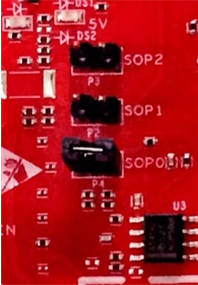SPRUIT8D February 2020 – February 2021 AWR2243
- Trademarks
- 1Getting Started
- 2Hardware
- 3Design Files and Software Tools
- 4Design Revision History
- 5Mechanical Mounting of PCB
- 6PCB Storage and Handling Recommendations
- 7Regulatory Information
- 8Revision History
2.7.1 Sense On Power Jumpers
The AWR2243 device can be set to operate in three different modes, based on the state of the SOP (sense on power) lines (see Figure 2-12). These lines are only sensed during boot up of the AWR device. The state of the device is described by Table 2-4.
A closed jumper refers to a 1 and an open jumper refers to a 0 state of the SOP signal going to the AWR device.
Table 2-4 SOP Modes
| Reference | Use | Comments |
|---|---|---|
| P3 (SOP 2) | SOP[2:0] | 101 (SOP mode 5) = Flash programming 001 (SOP mode 4) = Functional mode 011 (SOP mode 2) = Dev mode |
| P2 (SOP 1) | ||
| P4 (SOP 0) |
 Figure 2-12 SOP Jumpers
Figure 2-12 SOP Jumpers